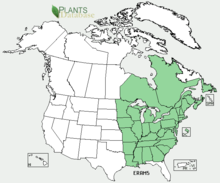Yellow trout lily

Overview
The yellow trout lily (Erythronium americanum) is a common spring ephemeral wildflower that is native to the northeastern United States and eastern Canada. It is a perennial that grows in colonies and blooms between March and May. Each plant produces one bright yellow flower with backwards bending petals and has dark green leaves that are mottled with a purplish-brown coloration. Other names for the yellow trout lily include the American trout lily, eastern trout lily, yellow dogtooth violet, and adder's tongue. [1]

Growth and Reproduction
The natural habitat of yellow trout lilies is deciduous woodland, and they grow best in moist, acidic soil with part sun. The plants tend to grow in clumps, forming dense clusters of leaves and flowers, and typically reach 3 to 6 inches in height.[1] Two versions of the yellow trout lily exist: sterile plants that do not produce flowers and reproduce via runners, and the flowering plants that reproduce sexually via seeds.[2][3] Each flower contains 4-7 seeds that are typically released in June and July, about 40% of which will successfully germinate.[3][4] Interestingly, although yellow is the most common color for pollen in flowering plants, the pollen and anther color of yellow trout lilies can be either red or yellow. This variation has allowed researchers to track pollen distribution from these plants. One 2018 study found that specific pollinators may have preferences for one pollen color over the other[5]

==
References
- ↑ 1.0 1.1 University of Texas. (19 March 2019). Erythronium americanum. https://www.wildflower.org/plants/result.php?id_plant=eram5
- ↑ Holland, P. G. (1980). Transplant experiments with trout lily at Mont St Hilaire, Quebec. Journal of Biogeography, 261-267.
- ↑ 3.0 3.1 Tessier, J. T. (2012). Methods of belowground movement in Erythronium americanum. Northeastern Naturalist, 19(sp6), 77-88.
- ↑ Muller, R. N. (1978). The phenology, growth and ecosystem dynamics of Erythronium americanum in the northern hardwood forest. Ecological Monographs, 48(1), 1-20.
- ↑ Austen, E. J., Lin, S. Y., & Forrest, J. R. (2018). On the ecological significance of pollen color: a case study in American trout lily (Erythronium americanum). Ecology, 99(4), 926-937.